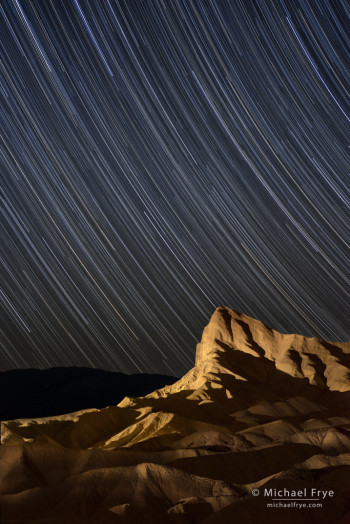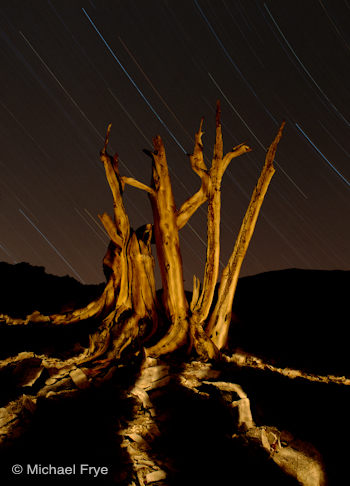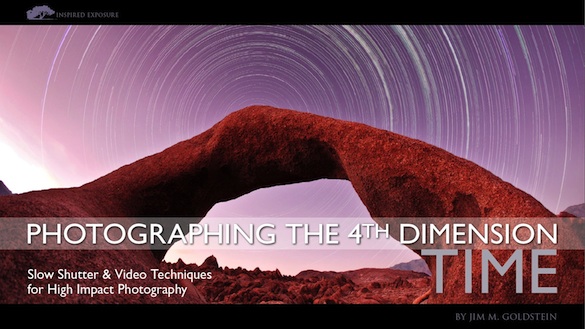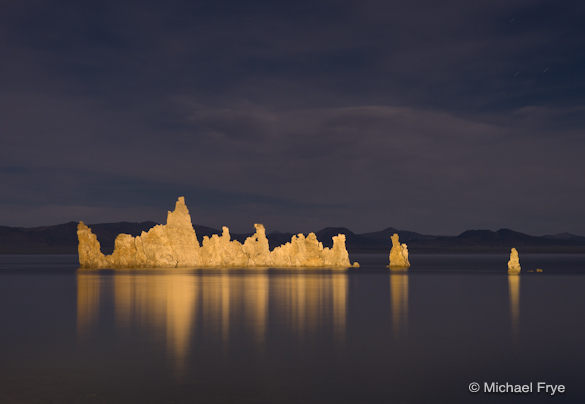by Michael Frye | May 10, 2015 | Night Photography

Manly Beacon at night with star trails, Death Valley NP, CA, USA
Manly Beacon is Death Valley’s most iconic feature, seen in millions of photographs from Zabriskie Point, including the image on the cover of the park map and brochure. So naturally I thought it would be fun to light it up at night.
One evening during our recent trip to Death Valley, Claudia and I, accompanied by our friend Robert Eckhardt, started down the Golden Canyon Trail from Zabriskie Point, carrying my powerful (3200 lumens), battery-powered spotlight, and radios for communication. Robert and I wanted a lower vantage point where the Beacon would poke up into the sky, and found a perfect spot. We set up our cameras and made some dusk exposures. Then after dark I hiked about half a mile further down the trail, carrying the spotlight and a radio, to a location I thought would work for the light-painting. Claudia acted as radio operator, and Robert tripped the shutters on both our cameras, while I used the spotlight to illuminate the Beacon.
We took a guess at the exposure, initially leaving the shutters open for 30 seconds at f/4, with the ISO set to 2500. According to Claudia and Robert’s radio reports, this exposure – surprisingly – turned out to be perfect. It did take several tries to get the lighting balance just right, but the problem was that the ridges underneath the Beacon weren’t getting lit from this spot. So I climbed back up the trail to a different location, closer to the cameras, which proved to be perfect for lighting those foreground ridges.
(more…)
by Michael Frye | Jun 26, 2012 | Vision and Creativity, Workshops

Bristlecone pine snag at night with star trails, White Mountains
Night photography offers wonderful opportunities to be creative. The low light allows you to use long exposures to record movement, like star trails or moonlit clouds. And since the natural light is so dim, you can easily overpower it with a flash or flashlight and add your own light to a scene.
That aspect of night photography—light-painting—has intrigued me for a long time. Adding your own light to a nighttime scene gives it a new dimension; it instantly transforms the landscape into something different, something we never see in real life, and adds a mysterious, surreal element to the photograph.
The accompanying image has both movement, in the form of star trails, and light-painting. I used a flashlight to trace the branches of this bristlecone pine snag, then painted zig-zag lines over the rocky foreground. I made this photograph with medium-format film back in September of 2000. Some test exposures with a Polaroid back helped me get the light-painting right, then I switched to real film (probably Provia), did the light-painting again, and then left the shutter open for another 90 minutes to record the star trails. You can see more examples of my light-painting techniques in my nighttime portfolio.
I learned light-painting with film, which was a slow trial-and-error (mostly error) process. Digital cameras make the learning curve much easier, because you can experiment and see the results immediately. If you’ve never tried night photography before this might be a fun summertime project—a way to stretch yourself a little and exercise your imagination. Summer is a great season for photographing landscapes at night, since the Milky Way is prominent, and the warm nighttime temperatures make it more comfortable to stay out late.
Whether you’re an experienced night photographer or a beginner, I recommend reading Lance Keimig and Scott Martin’s excellent book Night Photography: Finding Your Way in the Dark. Also, you can find tips about focus and exposure for moonlit landscapes in my post about photographing lunar rainbows.
And if you prefer hands-on learning there’s still space in my Full Moon Night Photography workshop later this summer (July 31st and August 1st). This is a great way to get personalized instruction and learn night photography in a fun, supportive group atmosphere. Rooms have been set aside for this workshop in Yosemite Valley and are still available if you register soon.
—Michael Frye
Related Posts: Under the Full Moon; Tips for Photographing Lunar Rainbows; Also, see images made by participants in last year’s night photography workshop in this Flickr group
Michael Frye is a professional photographer specializing in landscapes and nature. He is the author and photographer of The Photographer’s Guide to Yosemite, Yosemite Meditations, and Digital Landscape Photography: In the Footsteps of Ansel Adams and the Great Masters, plus the eBooks Light & Land: Landscapes in the Digital Darkroom, and Exposure for Outdoor Photography. He has written numerous magazine articles on the art and technique of photography, and his images have been published in over thirty countries around the world. Michael has lived either in or near Yosemite National Park since 1983, currently residing just outside the park in Mariposa, California.
by Michael Frye | Dec 7, 2011 | Announcements, Reviews

Jim Goldstein has just released a new eBook called Photographing the 4th Dimension – Time. In the book Jim describes seven different slow shutter speed and video techniques for making more creative photographs—including long exposures, light-painting, star trails, time-lapse, and cinemagraphs.
This book is a great way to delve into some new, fun, and creative aspects of photography. If you’ve never tried photographing star trails, making time-lapse videos, or creating cinemagraphs, Jim makes it easy to get started by giving you step-by-step instructions, sometimes including video tutorials.
Just browsing through the book can inspire you to try some new techniques and give your photography a creative kick in the pants. Personally I was intrigued by the cinemagraphs, where part of a still photograph is animated. Some cinemagraphs I’d seen before looked rather cheesy, but after viewing some of the examples here I realize that they can be done subtly, and beautifully, so I’m eager to try them—and it’s nice to have Jim’s detailed instructions for doing so.
(more…)
by Michael Frye | Aug 14, 2011 | Workshops

Light-painted tufa towers at Mono Lake
My Full Moon Night Photography workshop ended just after midnight last night. We had a lot of fun. Once people learned the basics I think they realized that photographing after dark isn’t that difficult. Then their creative juices started flowing and they started light-painting tufa towers and juniper trees with abandon!
As a bonus, we saw a spectacular sunset at Mono Lake Friday evening. Here’s one of my photographs of that sunset, and a couple of images from South Tufa I made while working with students on light-painting techniques. I hope to post some of the participant’s images here also as soon as they’ve processed them.
(more…)












